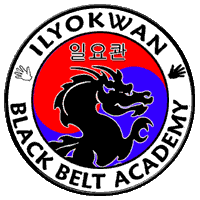What does Ilyokwan Mean?
Although we usually refer to our school as the Ilyokwan Black Belt Academy, technically, the full name for Master Olpin’s school is the “Ilyo Mu-do Kwan”.
![]()
![]()
![]()
This translates as follows:
Ilyo
The state of spiritual cultivation in Buddhism is called ‘Ilyo’ which means more or less ‘oneness’. When a state of Ilyo is achieved, body and mind and spirit are unified. The ultimate ideal of the Martial Arts can be found in this state. It is a discipline in which we concentrate on every movement leaving all materialistic thoughts, obsessions and external influences behind. We act in a perfect balance of mind, body and spirit with no need for conscious thought or external distractions.
This is the ultimate goal for a Martial Artist.
Mu-Do
Mu-Do simply translated is the Korean translation for “Martial Art”.
Kwan
Kwan is the Korean word for ‘School’, General Choi, the founder of Taekwondo named his school the ‘Oh Do Kwan’ (school of my way), there are many others, such as ‘Mu Duk Kwan’, ‘Han Mu Kwan’ etc. The term ‘Kwan’ does not in itself represent an art or style, simply the name of the school which was formed by a particular instructor.
The Ilyokwan Badge
The background of the Taegeuk, the red and blue version of the “Yin/Yang” – the universal symbol which signifies balance in all things. Taken from the South Korean flag to represent both the ‘balance’ of the oriental Yin/Yang symbolism and traditional roots of the art with it’s Korean heritage.
The Korean characters are ‘Il’, ‘Yo’ and ‘Kwan’.
The prominence of the Dragon is derived from the significance of the Dragon in oriental culture. Always a popular symbolism of the martial arts, the Dragon represents the most powerful of creatures, one which is revered for is timeless wisdom and ancient knowledge. The dragon is shrouded in mystery and never shows it true power unless it absolutely has to. The dragon symbolises the essence of a true Martial Artist.
The black and white hands on opposite sides of the patch further represent the concept of balance. On a technical level our style is a blending of both soft’ and ‘hard’ martial arts styles. We include concepts from the soft styles such as Aikido and Jujitsu, alongside dynamic striking and kicking from Taekwondo and Karate. Philosophically the white hand is ‘soft’ signifying the gentle path, the defensive side of the art. The black hand represents the necessity to sometimes revert to the ‘hard’ side – the martial knowledge of conflict, the actual physical confrontation. It reminds us that such conflict, the ‘dark side’, whilst sometimes necessary, should always be avoided if possible

